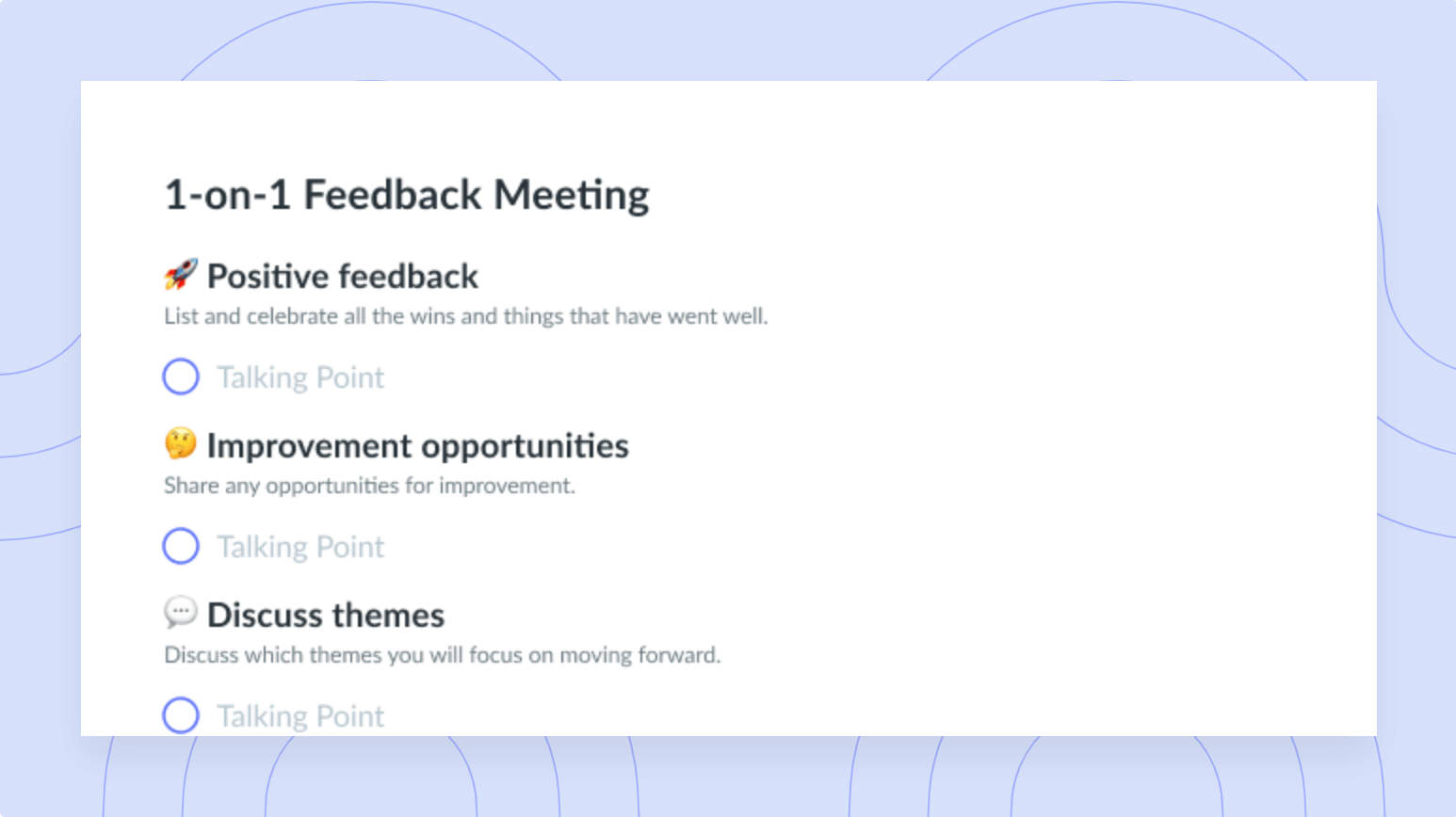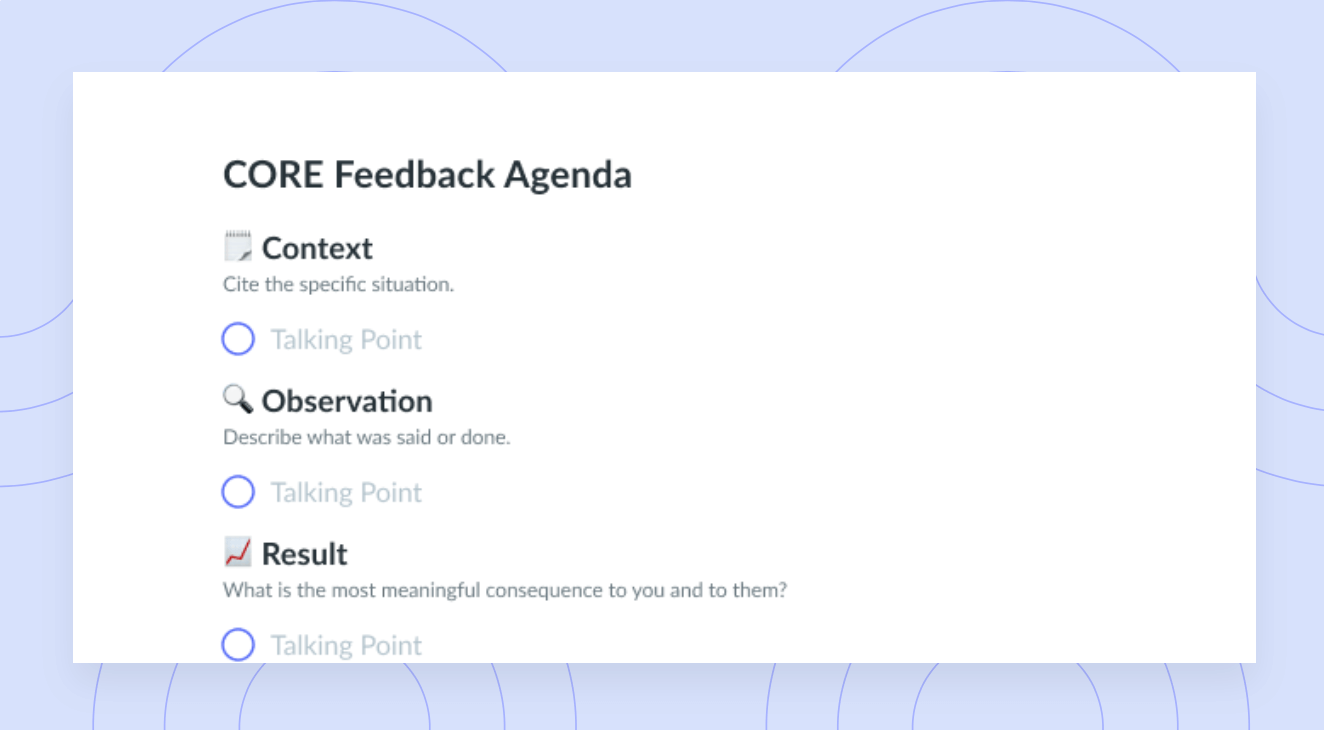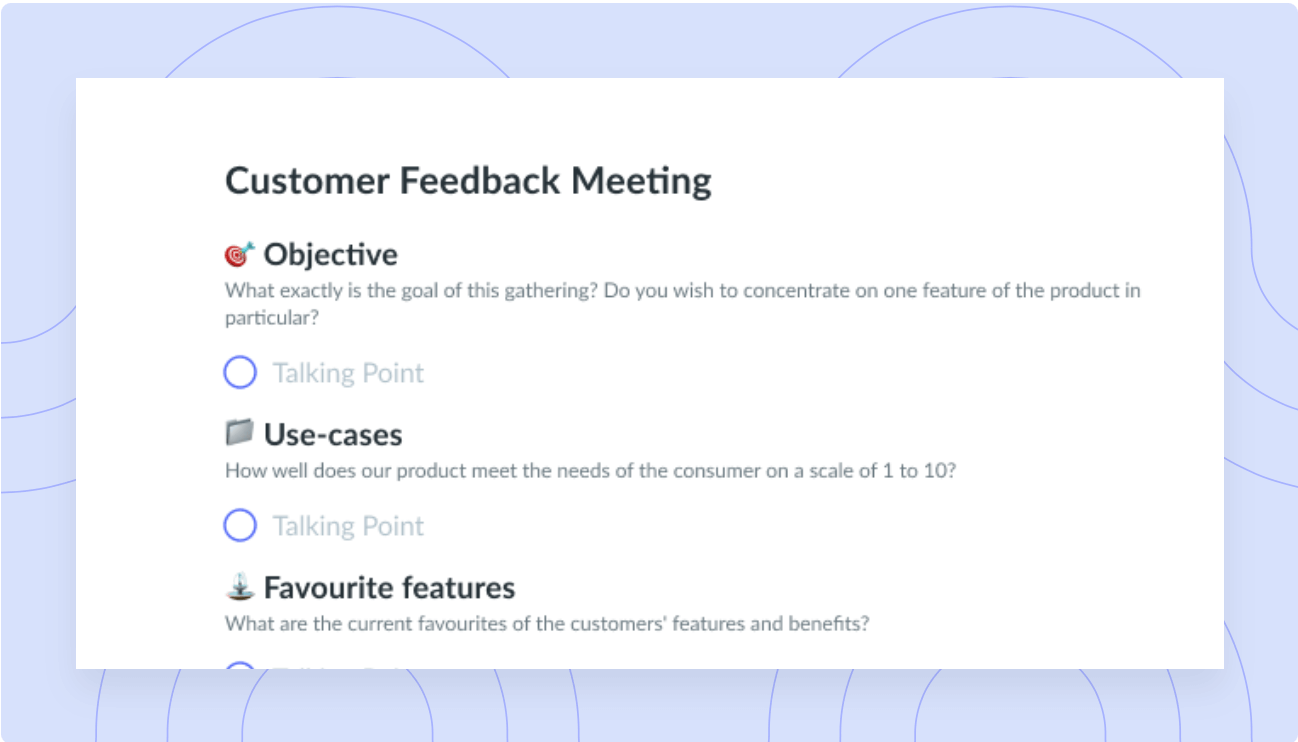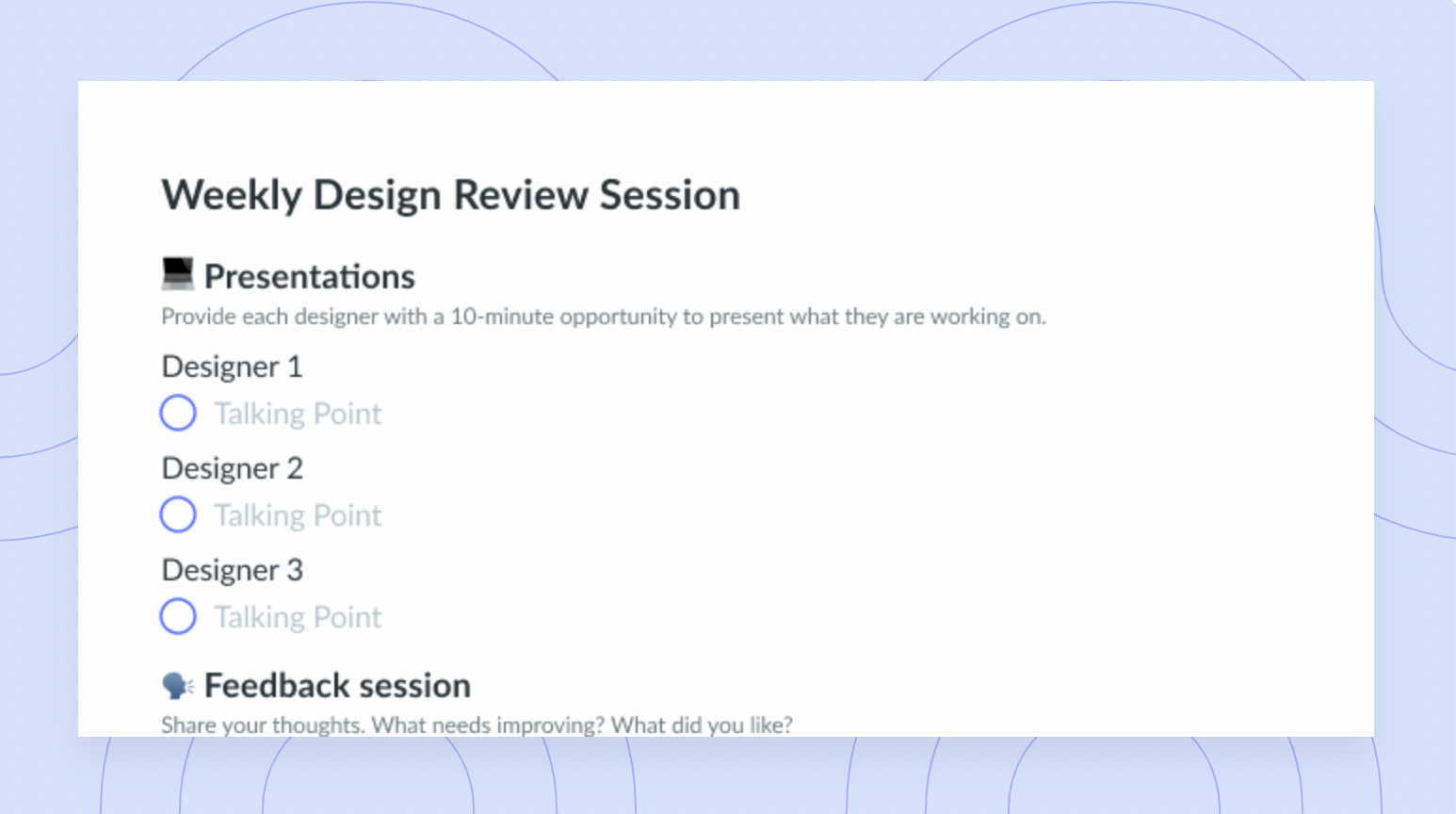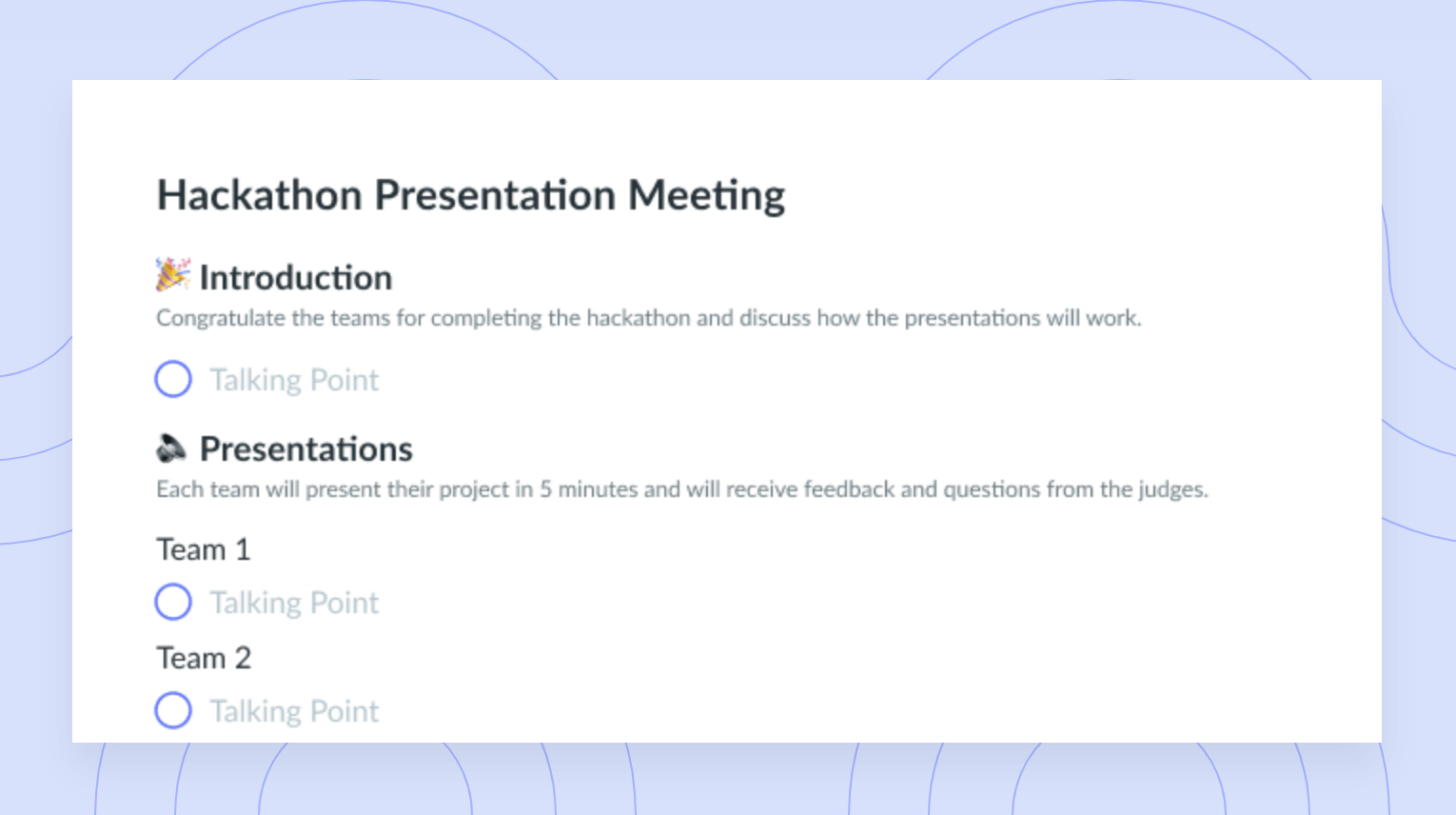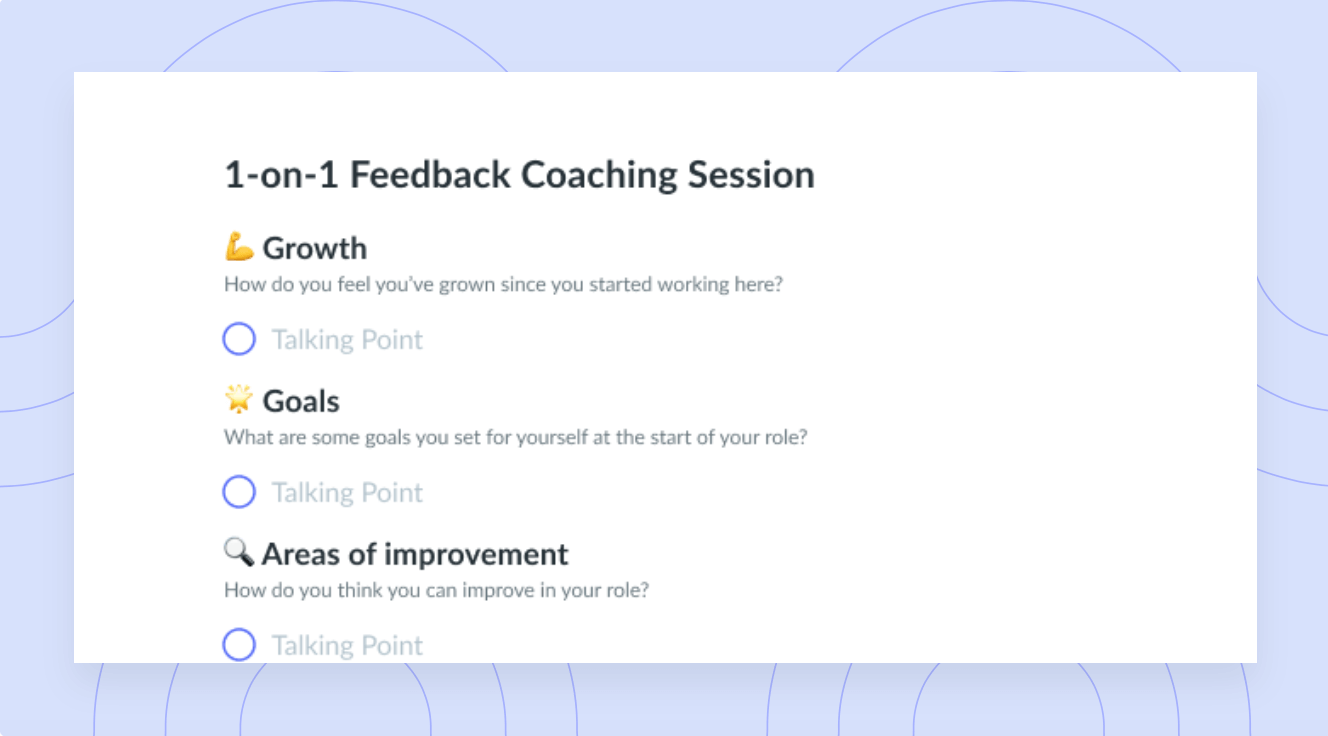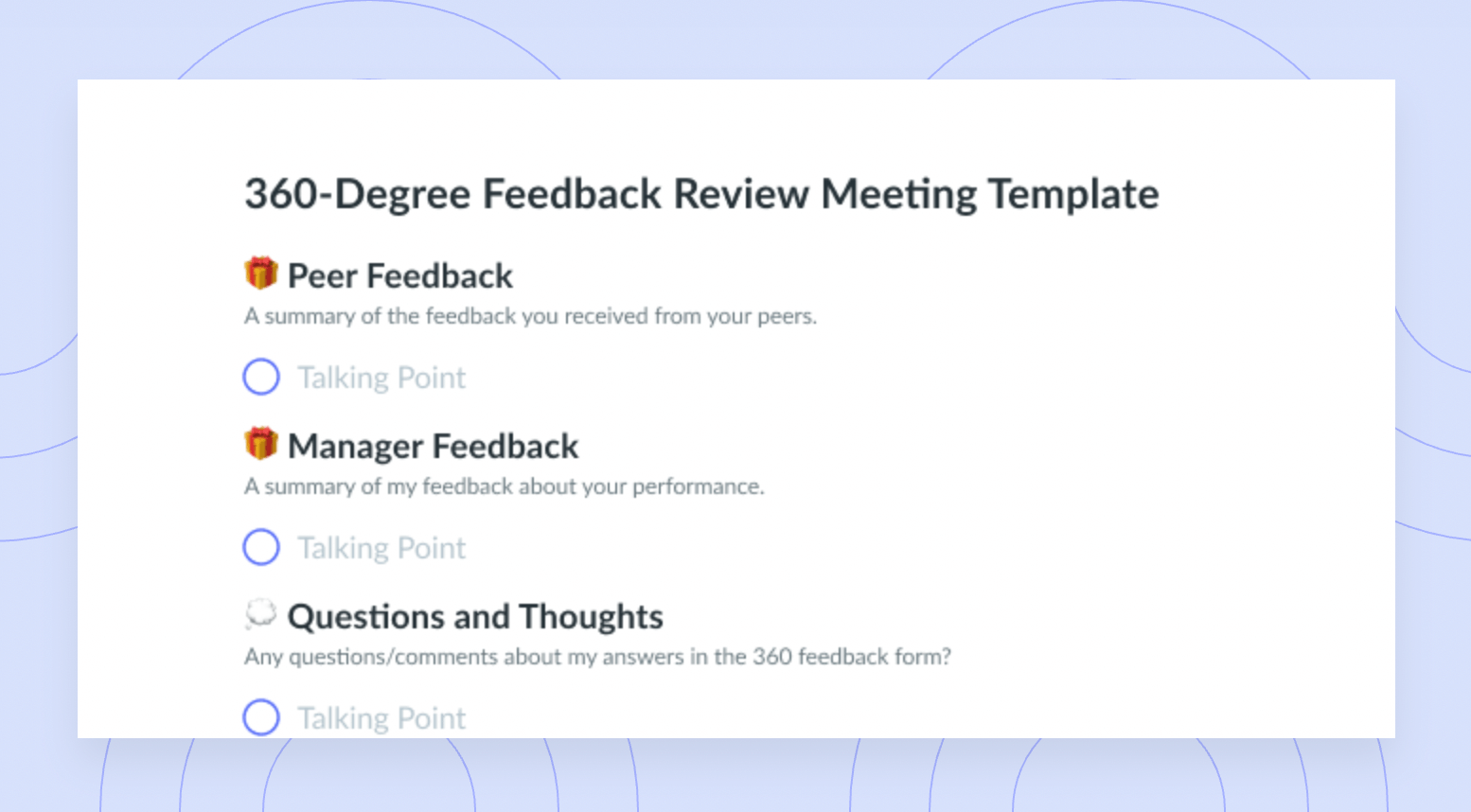How to Give Feedback to Colleagues: 10 Best Practices
Explore our best practices for giving employees and teammates positive and constructive feedback. Plus, get free meeting agenda templates for your next feedback meeting.
Feedback is one of the most helpful tools in a manager’s toolbox. By giving employees regular and consistent feedback, leaders can help individuals adopt new knowledge sooner, clarify expectations, and build confidence.
Today, let’s explore the importance of giving feedback, view some of the most common challenges associated with giving feedback to colleagues, see 10 best practices for delivering feedback, and understand how you can use Fellow to effectively give your teammates the great feedback they deserve.
- Why is it important to give feedback to colleagues?
- Common challenges with giving feedback to colleagues
- 10 best practices for giving feedback to colleagues
- How to effectively give colleagues feedback with Fellow
- Examples of feedback to colleagues
Why is it important to give feedback to colleagues?
“Researchers have found that we crave feedback but are uncomfortable or unwilling to deliver it. Yet the better feedback we provide, the more successful our organizations can become.”
— Robert Logemann, Forbes contributor
Think of positive and constructive feedback as a manager’s gift to employees. Offering regular feedback can improve your team’s culture, boost employee morale, and even increase productivity.
Positive feedback encourages individuals to continue certain behaviors. It helps them know when they’re excelling and shows them how valuable their contributions are. Constructive feedback, when delivered with consideration, can help employees expand on their existing habits. This type of feedback should challenge employees to grow and indicate that you’re willing to support them throughout the process.
Both types of feedback are critical for any company that wants to empower its employees through good and bad days!

Give and get feedback as work happens
A healthy and strong culture starts with feedback. Fellow enables your team to share real-time feedback on meetings, projects, and performance.

Common challenges with giving feedback to colleagues
Some of the most common issues associated with giving feedback to colleagues include time constraints, emotions, ambiguity, and other stressors. When faced with an employee who is underperforming, it can be challenging to deliver feedback in a delicate and considerate manner. It’s also important for managers to deliver constructive feedback clearly and kindly to avoid confusing or upsetting employees. Offering unclear feedback may cause colleagues to make assumptions and leave some individuals feeling confused.
Delivering feedback and offering follow-up support as a manager can be time consuming as well. The process requires trust, effective communication, and adequate time to take the person through the details and offer clarification.
10 best practices for giving feedback to colleagues
- Decide how to deliver the feedback
- Give actionable feedback
- Use performance management software
- Be specific and objective
- Encourage self-reflection
- Use the SBI model
- Stay consistent
- Document feedback
- Be transparent
- Follow up
1Decide how to deliver the feedback
Before you deliver any feedback, you must choose the best way to do it. Decide whether to offer your feedback in person, in a remote meeting environment, in a written email, or in an informal message. Most feedback is best delivered face-to-face, but there are times when it’s acceptable to send an email or message, too. For example, if an employee on your team did an excellent job presenting during a recent meeting, sending them a quick congratulatory note is a great informal way to show that you noticed their effort.
Unless you’re delivering the same feedback to more than one member of a group, always opt to give feedback in a one-on-one setting!
2Give actionable feedback
Actionable feedback is any feedback that provides clear guidance on what the employees can do to improve moving forward. When offering constructive feedback, you should always focus on actions and solutions rather than character. Focus on growth opportunities and offer specific problem-solving examples that will help the person improve. Remember, feedback without direction is nothing more than a complaint!
3Use performance management software
Performance management software helps track employee performance consistently and measurably. Some popular tools on the market include BambooHR, Workday, and Namely. Performance management tools are great options for managers looking to conduct performance appraisals and reviews or goal-setting sessions with employees.
When searching for a tool, look for software that is designed to improve business performance and that can help you build a feedback culture. For instance, Fellow enables your team to share real-time feedback on meetings, projects, and performance.
4Be specific and objective
When delivering feedback, focus on an individual’s actions and never their character. Be specific so that the individual can improve in the future. For example, if you’re delivering feedback based on their time management skills, don’t say, “You’re always turning things in late and missing deadlines.” Instead, say something along the lines of, “I’ve noticed that you’ve been turning some of your assignments in late. Specifically, you turned in last week’s budget report and analysis on Friday when I had originally asked for those pieces by Wednesday. Moving forward, let’s develop a plan so that I can support you in meeting your deadlines and so that you don’t feel overwhelmed.” This example clearly defines the problem and outlines the exact behavior you want them to improve.
5Encourage self-reflection
Encourage colleagues to take time to think about, evaluate, and give serious thought to the feedback you offer. Never force a person to respond in the moment to your constructive feedback. After delivering a piece of critical feedback, say something like, “I know this feedback may be difficult to process, so don’t feel the need to respond right now. Please feel free to sit with this feedback for a few hours or days and know that I am here to support you in improving when you’re ready.” Giving them time to process what you’ve said will help the colleague better understand what they must do in the future.
6Use the SBI model
SBI stands for situation-behavior-impact. The SBI model is a proven way to reduce anxiety by offering clear step-by-step instructions on how to approach difficult feedback conversations with colleagues. At the start of any feedback conversation, clearly describe the Situation and any details about when and where it occurred. Next, describe the Behavior you observed. Never assume that you know what the other person was thinking at the time and refrain from making judgments on their character. Lastly, outline the Impact of the behavior. At this last stage, describe what you thought and felt at this time about the situation.
7Stay consistent
Feedback should be a continuous and ongoing process. Individuals learn and grow best when there is a feedback loop in place. Give feedback regularly and offer the tools and resources your colleagues need to implement the feedback and make improvements. Once they’ve refined their new skills, offer new feedback so the loop can begin again.
8Document feedback
It’s important to document feedback so that you have access to the history of the performance comments you’ve given and received. Did you know that all feedback in Fellow is automatically documented and stored in our app for you to retrieve at any time? Fellow users can access an inbox within our Feedback feature to view a history of the feedback they’ve sent and received. The inbox features categories including needs action, requests sent, feedback sent, drafts, and archived, and operates like an email inbox so you can view everything in one space.
9Be transparent
“You have to encourage radical candor within an organization. It’s very important, especially nowadays, for organizations to be open and transparent, so that people can raise their hands and say, ‘Hey, there is some problem happening in this particular function and we need to fix it.’ They should feel safe doing that.”
— Raj Sarkar, Supermanagers podcast
Transparency is key when delivering positive or constructive feedback. Be open and honest when offering suggestions to colleagues. Don’t feel the need to lie or sugarcoat the impact of someone’s poor decision or behavior because it won’t help them improve in the long run. Offering regular transparent feedback will create a culture of trust and lead to better communication within your team. However, remember that transparency is never an excuse to be mean to a colleague!
10Follow up
A few days or weeks after you offer a colleague feedback, set up a follow-up meeting or send a message to check in. Ask the person how they felt about the feedback, whether they have any feedback for you, and ask if they have any questions or need any support as they begin implementing it.
How to effectively give colleagues feedback with Fellow
“One of the best additions to our feedback loop has been the company-wide adoption of Fellow. It provides an amazing platform for constant conversations and direct feedback between managers and direct reports.”
— Justin Schiefner, VP of People Operations & Culture at Arkose Labs
Fellow is the all-in-one meeting tool your team needs to host amazing meetings and give meaningful feedback. With Fellow’s Feedback feature, managers and employees can share real-time feedback on meetings, projects, and performance. Begin normalizing feedback by incorporating opportunities to deliver positive and constructive feedback into your team’s day-to-day experience. Keep a history of the feedback you exchange and receive to visualize your growth over time.
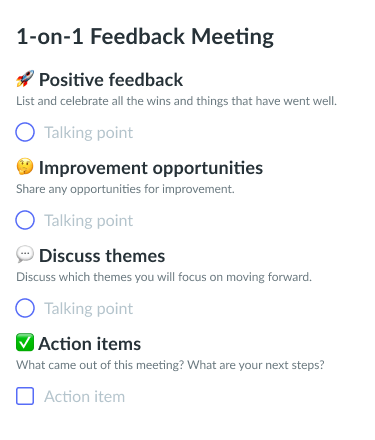
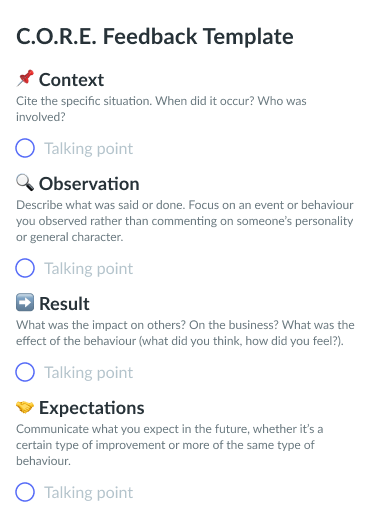
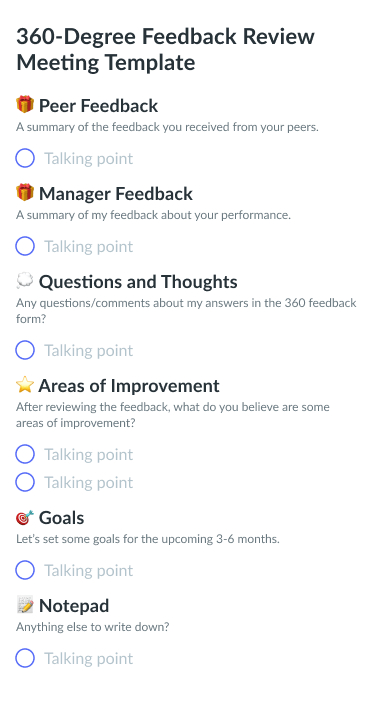
Examples of feedback to colleagues
Here are some examples of feedback you can offer your colleagues in a few different situations:
- An employee who handled a difficult situation well: “Something I appreciate about you is your aptitude for solving problems during stressful times. I noticed how collaborative you were during our last team brainstorming session to resolve that client issue we were facing. Thank you for being a leader on our team!”
- An underperforming teammate: “I noticed that you’re struggling to make it on time to our weekly team sessions and I’m concerned that you might be missing some important information. How can I best support you so that you can show up on time and be prepared for these meetings moving forward?”
- A colleague who went above and beyond: “I’m blown away by your dedication to this project! You went above and beyond and it’s evident how hard you worked to deliver ahead of schedule. Thank you!”
Parting advice
Feedback may feel awkward or unnatural to give at first, but can make all the difference in helping your teammates improve their skills. The next time you notice an individual or group doing something well or in need of improvement, offer up your feedback to show them that you care!


![20 Positive Feedback Examples for Employees [+ FREE templates]](https://fellow.app/wp-content/uploads/2022/04/feedback.jpg)
![How to Use the SBI Feedback Model [+ Examples]](https://fellow.app/wp-content/uploads/2023/12/SBI-feedback-model-2.jpg)





